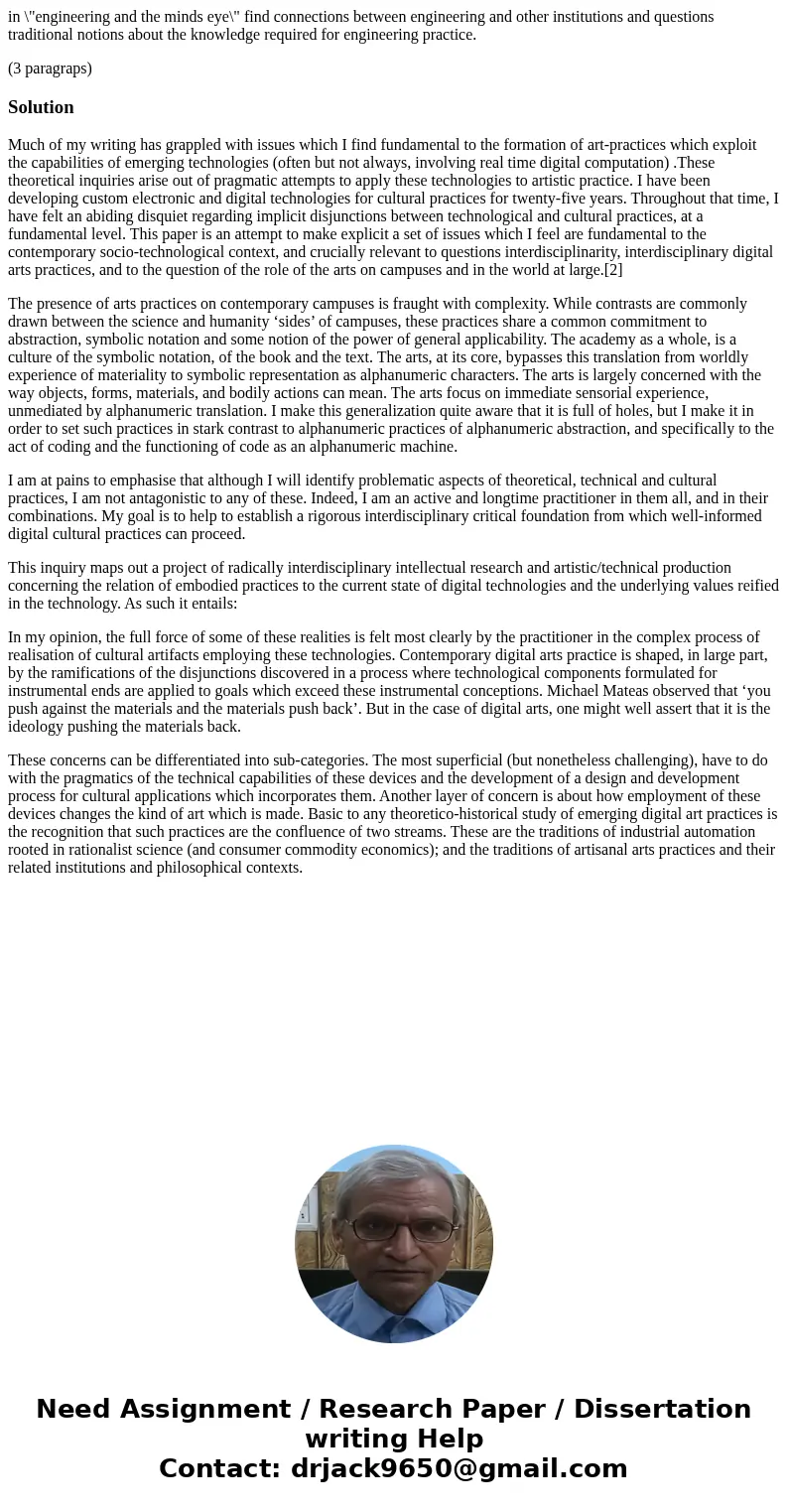in engineering and the minds eye find connections between en
in \"engineering and the minds eye\" find connections between engineering and other institutions and questions traditional notions about the knowledge required for engineering practice.
(3 paragraps)
Solution
Much of my writing has grappled with issues which I find fundamental to the formation of art-practices which exploit the capabilities of emerging technologies (often but not always, involving real time digital computation) .These theoretical inquiries arise out of pragmatic attempts to apply these technologies to artistic practice. I have been developing custom electronic and digital technologies for cultural practices for twenty-five years. Throughout that time, I have felt an abiding disquiet regarding implicit disjunctions between technological and cultural practices, at a fundamental level. This paper is an attempt to make explicit a set of issues which I feel are fundamental to the contemporary socio-technological context, and crucially relevant to questions interdisciplinarity, interdisciplinary digital arts practices, and to the question of the role of the arts on campuses and in the world at large.[2]
The presence of arts practices on contemporary campuses is fraught with complexity. While contrasts are commonly drawn between the science and humanity ‘sides’ of campuses, these practices share a common commitment to abstraction, symbolic notation and some notion of the power of general applicability. The academy as a whole, is a culture of the symbolic notation, of the book and the text. The arts, at its core, bypasses this translation from worldly experience of materiality to symbolic representation as alphanumeric characters. The arts is largely concerned with the way objects, forms, materials, and bodily actions can mean. The arts focus on immediate sensorial experience, unmediated by alphanumeric translation. I make this generalization quite aware that it is full of holes, but I make it in order to set such practices in stark contrast to alphanumeric practices of alphanumeric abstraction, and specifically to the act of coding and the functioning of code as an alphanumeric machine.
I am at pains to emphasise that although I will identify problematic aspects of theoretical, technical and cultural practices, I am not antagonistic to any of these. Indeed, I am an active and longtime practitioner in them all, and in their combinations. My goal is to help to establish a rigorous interdisciplinary critical foundation from which well-informed digital cultural practices can proceed.
This inquiry maps out a project of radically interdisciplinary intellectual research and artistic/technical production concerning the relation of embodied practices to the current state of digital technologies and the underlying values reified in the technology. As such it entails:
In my opinion, the full force of some of these realities is felt most clearly by the practitioner in the complex process of realisation of cultural artifacts employing these technologies. Contemporary digital arts practice is shaped, in large part, by the ramifications of the disjunctions discovered in a process where technological components formulated for instrumental ends are applied to goals which exceed these instrumental conceptions. Michael Mateas observed that ‘you push against the materials and the materials push back’. But in the case of digital arts, one might well assert that it is the ideology pushing the materials back.
These concerns can be differentiated into sub-categories. The most superficial (but nonetheless challenging), have to do with the pragmatics of the technical capabilities of these devices and the development of a design and development process for cultural applications which incorporates them. Another layer of concern is about how employment of these devices changes the kind of art which is made. Basic to any theoretico-historical study of emerging digital art practices is the recognition that such practices are the confluence of two streams. These are the traditions of industrial automation rooted in rationalist science (and consumer commodity economics); and the traditions of artisanal arts practices and their related institutions and philosophical contexts.

 Homework Sourse
Homework Sourse